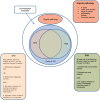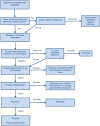Insights into the evaluation and management of dyspepsia: recent developments and new guidelines
- PMID: 30397412
- PMCID: PMC6207968
- DOI: 10.1177/1756284818805597
Insights into the evaluation and management of dyspepsia: recent developments and new guidelines
Abstract
Dyspepsia is a very common gastrointestinal (GI) condition worldwide. We critically examine the recommendations of recently published guidelines for the management of dyspepsia, including those produced jointly by the American College of Gastroenterology and the Canadian Association of Gastroenterology, and those published by the UK National Institute for Health and Care Excellence. Dyspepsia is a symptom complex, characterized by a range of upper GI symptoms including epigastric pain or burning, early satiety, and post-prandial fullness. Although alarm features are used to help prioritize access to upper GI endoscopy, they are of limited utility in predicting endoscopic findings, and the majority of patients with dyspepsia will have no organic pathology identified at upper GI endoscopy. These patients are labelled as having functional dyspepsia (FD). The Rome IV criteria, which are used to define FD, further subclassify patients with FD as having either epigastric pain syndrome or post-prandial distress syndrome, depending on their predominant symptoms. Unfortunately, the Rome criteria perform poorly at identifying FD without the need for upper GI endoscopy. This has led to the investigation of alternative diagnostic approaches, including whether a capsaicin pill or combined serum biomarkers can accurately identify patients with FD. However, there is insufficient evidence to support either of these approaches at the present time. Patients with FD should be tested for H. pylori infection and be prescribed eradication therapy if they test positive. If they continue to have symptoms following this, then a trial of treatment with a proton pump inhibitor (PPI) should be given for up to 8 weeks. In cases where symptoms fail to adequately respond to PPI treatment, a tricyclic antidepressant may be of benefit, and should be continued for 6 to 12 months in patients who respond. Prokinetics demonstrate limited efficacy for treating FD, but could be considered if other strategies have failed. However, there are practical difficulties due to their limited availability in some countries and the risk of serious side effects. Patients with FD who fail to respond to drug treatments should be offered psychological therapy, where available. Overall, with the exception of recommendations relating to H. pylori testing and the prescription of PPIs, which are made on the basis of high-quality evidence, the evidence underpinning other elements of dyspepsia management is largely of low-quality. Consequently, there are still many aspects of the evaluation and management of dyspepsia that require further research.
Keywords: Dyspepsia; Functional disease; Guidelines; Rome criteria.
Conflict of interest statement
Conflict of interest statement: The authors declare that there is no conflict of interest.
Figures




References
-
- Ford AC, Marwaha A, Sood R, et al. Global prevalence of, and risk factors for, uninvestigated dyspepsia: a meta-analysis. Gut 2015; 64: 1049–1057. - PubMed
-
- Ford AC, Forman D, Bailey AG, et al. Who consults with dyspepsia? Results from a longitudinal 10-yr follow-up study. Am J Gastroenterol 2007; 102: 957–965. - PubMed
-
- Lacy BE, Weiser KT, Kennedy AT, et al. Functional dyspepsia: the economic impact to patients. Aliment Pharmacol Ther 2013; 38: 170–177. - PubMed
-
- Aro P, Talley NJ, Agreus L, et al. Functional dyspepsia impairs quality of life in the adult population. Aliment Pharmacol Ther 2011; 33: 1215–1224. - PubMed
Publication types
LinkOut - more resources
Full Text Sources

